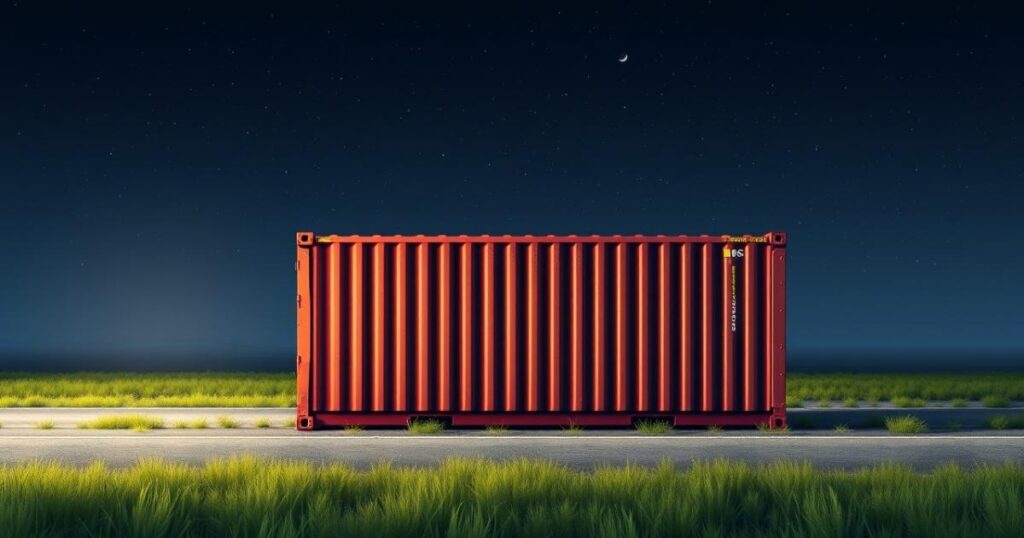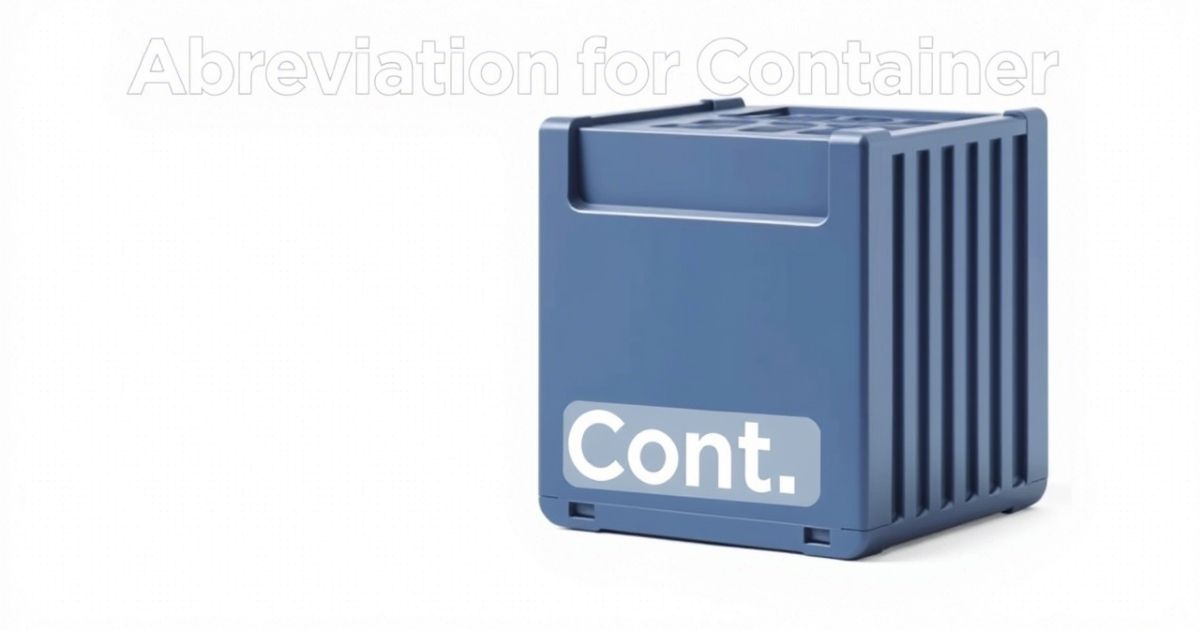The Abbreviation for Container is a commonly used shorthand in various industries, especially in logistics and shipping. It’s often abbreviated as “Cont.” to save space and make communication more efficient. The Abbreviation for Container is helpful in managing shipments, labeling storage boxes, and organizing inventory. When dealing with large quantities of goods, using the Abbreviation for Container helps keep things concise and clear. This abbreviation is seen on shipping labels, manifests, and storage instructions, allowing workers and businesses to streamline their processes.
In everyday life, the Abbreviation for Container can also be useful, especially when space is limited. Whether you’re storing items at home or organizing a warehouse, the Abbreviation for Container simplifies tasks. From organizing food containers to labeling boxes for moving, the Abbreviation for Container ensures that everything is labeled properly without taking up too much room. It’s a small yet practical tool for improving efficiency in both personal and professional settings.
What is the Abbreviation for Container?
The abbreviation for Container is “Cont.” It’s often used when space is limited, like on shipping documents or storage labels, making it easier to keep things concise.
For instance, you might see it in contexts like:
- “Cont. arriving at 10 AM” on a shipment schedule.
- “Store in a 20 ft. cont.” for storage instructions.
This abbreviation is especially helpful in logistics and organization, whether for business or personal use.
What Does Container Mean? A Closer Look
The meaning of a container can change depending on the situation. Here’s how it’s commonly used:
- In Shipping and Logistics: A container is a large, standardized box used for transporting goods over long distances, usually by sea, truck, or rail. These containers typically come in sizes like 20 or 40 feet.
- In Everyday Life: A container is any object that holds or stores things, from a plastic storage bin to a simple lunchbox.
Examples:
- “The container full of goods arrived at the warehouse.”
- “I store extra blankets in a container under my bed.”
In all cases, the essential purpose of a container is to hold or store something, making it more organized and easy to transport.
Definition, Pronunciation, and Meaning of Container

Definition:
A container is any object or structure used to hold, store, or transport items. It can be something as simple as a box or as large as a shipping crate, designed to protect and organize goods.
Pronunciation: /kənˈteɪnər/
(kuhn-TAY-nur)
Meaning:
In general use, a container is any item that can hold or store things, such as a jar, box, or bag. It’s used to keep things secure and organized. In shipping and logistics, a container refers to a large, standardized box used to transport goods over long distances, typically on ships, trucks, or trains. These are often made from metal and come in various sizes, with 20 and 40 feet being common.
Examples:
- “I packed the clothes in a container for the move.”
- “The shipping container arrived at the port after a long journey.”
In both everyday and industrial contexts, a container serves the purpose of storing, holding, or transporting goods securely.
Understanding the Word “Container”
The word container refers to any object or structure designed to hold, store, or transport items. It can be a simple household item, like a jar or a box, or a large industrial structure, like a shipping crate. The key function of a container is to securely hold contents and often to keep them organized or protected during transport.
In everyday life, containers come in all shapes and sizes anything that holds things qualifies as a container. For instance, a plastic bin can be used for organizing household items, while a lunchbox holds your meal.
In the logistics and shipping industry, the term refers to larger, standardized boxes used to transport goods across long distances. These shipping containers are typically made of durable materials like steel and come in standard sizes, usually 20 feet or 40 feet in length. These containers are stacked on ships, trains, or trucks, facilitating the global movement of goods.
Examples:
- “I use a container to store my winter clothes in the attic.”
- “The shipping container arrived at the dock with all the goods.”
No matter how it’s used, the concept of a container is simple: it’s anything that holds or stores something.
How to Pronounce Container
To pronounce “container”, follow this guide:
Pronunciation: /kənˈteɪnər/
It sounds like: kuhn-TAY-nur.
- “kuhn” : The first syllable sounds like “cun,” with a soft “uh” sound.
- “TAY” : The second syllable is stressed and sounds like the word “tay.”
- “nur” : The final syllable sounds like “ner,” with a soft “uh” sound.
Putting it all together, it’s kuhn-TAY-nur.
Related Guide:
Cabron: Meaning, Uses, and Practical Examples
Short Abbreviation for Container
The short abbreviation for container is “Cont.” It’s frequently used in areas like logistics, shipping, and sometimes even in personal organization where space is tight.
Whether you’re labeling storage boxes or managing shipments, “Cont.” offers a quick way to refer to containers.
For instance:
- “Cont. #5678 is scheduled for delivery.”
- “Place the extra items in a large cont. for easy storage.”
Using “Cont.” keeps things clear and concise, especially when space is limited, such as on shipping labels or in warehouse records.
Acronym for Container: Does It Exist?

Is there an acronym for container? Not really! Unlike some words in logistics, container doesn’t have a widely accepted acronym.
Instead, the common abbreviation we use is “Cont.” to keep things short and clear. That said, there are a couple of other acronyms in shipping related to containers, such as:
- “F.C.L.” (Full Container Load)
- “L.C.L.” (Less than Container Load)
These acronyms are used to describe how goods are packed into containers, but when referring specifically to container, “Cont.” is the go-to abbreviation.
Synonyms for Container
Here are some synonyms for container that you might find useful depending on the context:
- Receptacle : A general term for anything used to hold or store something.
- Box : Often used for storing or transporting items.
- Bin : A container, often used for storing goods or materials.
- Vessel : A broader term, commonly used for containers in the context of liquids.
- Canister : Typically used for small, cylindrical containers.
- Caddy : A small container, often used for organizing items like tea bags or spices.
Each of these synonyms works in different situations, so it’s good to pick the right one depending on what you’re referring to!
Antonym for Container
The antonym for container would generally refer to something that empties or releases its contents. Here are some possible antonyms:
- Empty : Lacking contents or not containing anything.
- Dispenser : A device that releases or dispenses items or substances.
- Outlet : A place or device through which something is released or expelled.
- Receiver : Something that accepts or receives rather than holds or stores.
- Extractor : A tool or device used to remove contents.
These terms are opposite to a container since they focus on releasing, dispensing, or removing rather than holding or storing.
The History of the Word Abbreviation for Container
The abbreviation for container has roots in early logistics and shipping industries. As global trade grew, the need for quick notation became vital. Shippers used shortened terms to label and track goods efficiently.
By the 20th century, the abbreviation for container became standardized in transportation sectors. Terms like “CNT” or “CTR” appeared in freight documents. These codes helped avoid confusion and saved space on labels.
The military played a role in popularizing the abbreviation for container during wartime logistics. Quick identification of supplies became a top priority. Abbreviations helped streamline operations across regions and languages.
Today, the abbreviation for container is common in inventory systems and global trade databases. It’s used in spreadsheets, customs forms, and warehouse labels. Abbreviations ensure speed and clarity in data processing.
Understanding the abbreviation for container offers insight into the evolution of shipping language. It reflects how industries adapt to save time and space. From ports to packaging, it’s a symbol of efficiency in motion.
When to Use the Abbreviation for Container

Using the abbreviation for container depends on the context and the audience you are addressing. Here’s when it’s appropriate to use the abbreviation:
- Industry-Specific Contexts: In fields like logistics, shipping, or manufacturing, abbreviations like “cont.” are commonly used. These sectors often use shorthand to streamline communication, especially in written forms such as invoices, inventory lists, or shipping documentation.
- Informal or Internal Communication: When sending internal notes, emails, or messages within a team, abbreviations like “cont.” might be acceptable to save time, as long as the audience understands the term.
- Space Constraints: If you’re working within limited space, such as on a label, a form, or a technical drawing, abbreviations are helpful for clarity and brevity.
In short, always consider your audience and purpose before using an abbreviation. If there’s any doubt, it’s safer to write out the full word.
Examples of the Word and Abbreviations in Context
To give you a clear idea of how the word “container” and its abbreviation “Cont.” can be used, here are some examples:
- Full Word Example: “The container arrived at the warehouse ahead of schedule.”
Abbreviation Example: “Cont. A17 needs to be moved to the loading dock.” - Full Word Example: “Every container is sealed and scanned before storage.”
Abbreviation Example: “Cont. 005 is holding temperature-sensitive supplies.” - Full Word Example: “They inspected each container for signs of damage.”
Abbreviation Example: “Label Cont. 32C as ‘fragile’ and handle with care.”
FAQ’s
What does Cont. stand for in logistics?
The abbreviation for container is Cont.. It’s commonly used in shipping documents to represent containers in a more concise manner.
How is Cont. used in storage?
When organizing items, the Abbreviation for Container simplifies labeling. Instead of writing the full word, you can just use Cont. to save space.
What does Cont. refer to in a shipping manifest?
In shipping manifests, the Abbreviation for Container is often seen as Cont.. This helps keep details short while still clearly identifying the container type.
Why do we use Cont. in warehouse management?
The Abbreviation for Container helps warehouse workers efficiently label and track items. It’s a quick and practical way to reference storage containers.
Where is Cont. commonly found?
You’ll often see the Abbreviation for Container on shipping labels, storage boxes, or inventory lists. It’s a handy way to streamline logistics and organization.
Conclusion
The Abbreviation for Container is a practical tool that helps streamline various tasks in shipping, storage, and organization. By using “Cont.,” individuals and businesses can save time and space, making communication more efficient. The Abbreviation for Container is essential in logistics, helping to label and track shipments quickly and clearly. It’s also useful for organizing inventory, ensuring that goods are stored and moved with ease.
The Abbreviation for Container plays a crucial role in both professional and everyday settings. Whether you’re managing a warehouse or simply organizing items at home, the Abbreviation for Container keeps things clear and concise. By using the Abbreviation for Container, you can ensure that everything is properly labeled and easy to find. Overall, the Abbreviation for Container is a simple but effective way to stay organized and improve efficiency in various areas of life.

Atlas Reid is an experienced administrator with 5 years of expertise in managing operations, streamlining processes, and ensuring efficiency. Skilled in leadership, organization, and problem-solving to drive business success.








